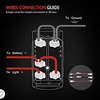Hello, I don’t know much about electrical currents.
I just bought an LED Light bar for my truck and I am just curious about how I should wire it up. There are a few different pieces, and I would like to add maybe another bar later on.
Here are the specs:
-Power: 300 Watt
-Voltage: 10-30V DC
-Beam Angle: Combo (spot&flood)
-LED color: White (6000K)
-Raw Lumens: 27,000 lm
-Material: Aluminum Alloy Metal Housing, PC Lens
-Waterproof Level: IP67
-Life Span: 50,000 hours
-Dimension: 52x 2.3 x 2.6 inches
The second is a pair of spot beams/bars:
I am wondering if there some sort of power regulator in there.
Also, a bonus question. They are still boxed up and Id like to test them out, I have one of those lithium car jump starter things. If I tried connecting the light bar to the cables, would I fry everything/pop a fuse, or would it be just fine?
Thanks
I just bought an LED Light bar for my truck and I am just curious about how I should wire it up. There are a few different pieces, and I would like to add maybe another bar later on.
Here are the specs:
-Power: 300 Watt
-Voltage: 10-30V DC
-Beam Angle: Combo (spot&flood)
-LED color: White (6000K)
-Raw Lumens: 27,000 lm
-Material: Aluminum Alloy Metal Housing, PC Lens
-Waterproof Level: IP67
-Life Span: 50,000 hours
-Dimension: 52x 2.3 x 2.6 inches
The second is a pair of spot beams/bars:
- LED type: 5050-SMD (Total 48 LEDs)
- Color Temperature: 6000K (Pure White)
- Beam Angle: 30°(spot beam) Long distance illumination
- Power: 120W (Single unit)
- Operating Voltage: 9 - 30V DC
- Luminous flux: 12,000 LM (Single unit)
- Light Transmission Rate: 98%
I am wondering if there some sort of power regulator in there.
Also, a bonus question. They are still boxed up and Id like to test them out, I have one of those lithium car jump starter things. If I tried connecting the light bar to the cables, would I fry everything/pop a fuse, or would it be just fine?
Thanks









